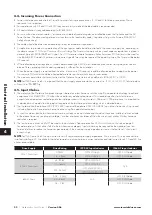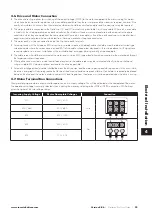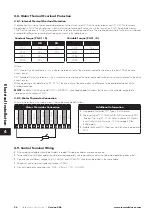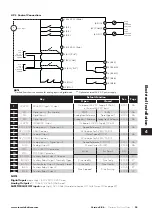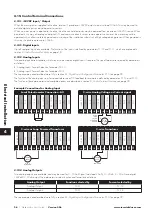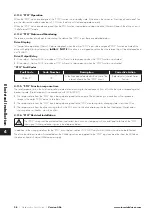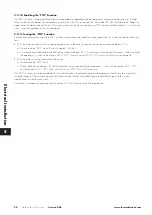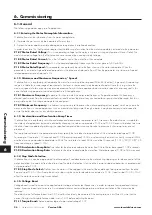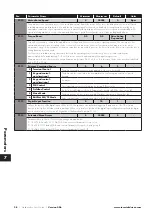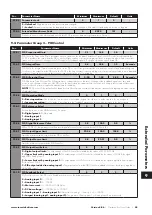
36
| Optidrive Eco User Guide |
Version 3.06
www.invertekdrives.com
6. Commissioning
6.1. General
The following guidelines apply to all applications:
6.1.1. Entering the Motor Nameplate Information
Optidrive Eco uses the information from the motor nameplate to:
Operate the mot or with the best possible efficiency level.
Protect the motor against possible damage due to operation in overload condition.
In order to achieve this, the Optidrive requires that the following information from the motor nameplate is entered into the parameters:
P1-07 Motor Rated Voltage.
This is the operating voltage for the motor in its present wiring configuration (Star or Delta). The
maximum output voltage from the Optidrive can never exceed the incoming supply voltage.
P1-08 Motor Rated Current.
This is the full load current of the motor from the nameplate.
P1-09 Motor Rated Frequency.
This is the standard operating frequency of the motor, generally 50 or 60Hz.
P1-10 Motor Rated Speed.
This parameter can optionally be set to the Rpm shown on the motor nameplate. When this
parameter is entered, all speed related parameters in the drive are displayed in Rpm. When the parameter is set to zero, all speed
related parameters are displayed in Hz.
6.1.2. Minimum and Maximum Frequencies / Speeds
Optidrive Eco units are factory set to operate the motor from zero up to base speed (50 or 60Hz output). In general, this operating
range is suitable for a wide range of requirements, however in some cases it may be desired to adjust these limits, e.g. where the
maximum speed of a fan or pump may provide excessive flow, or where operation below a certain speed is never required. In this
case, the following parameters can be adjusted to suit the application:
P1-01 Maximum Frequency.
In general this should match the motor rated frequency. If operation above this frequency is
desired, confirmation from the motor manufacturer, and the manufacturer of any connected fan or pump should be sought that this is
permissible, and will not cause damage to the equipment.
P1-02 Minimum Frequency.
A suitable minimum can be set to prevent the motor operating at low speed, which may cause the
motor to overheat. In some applications, such as a pump circulating water through a boiler, it may be necessary to set a speed to
ensure the boiler does not run dry during operation.
6.1.3. Acceleration and Deceleration Ramp Times
Optidrive Eco units are factory set with acceleration and deceleration ramp rates set to 30 seconds. The default value is suitable for
the majority of applications but can be altered by changing the values in parameters P1-03 and P1-04. Care must be taken to ensure
the driven load is capable of performing the specified ramps and that nuisance trips due to excessively short ramp times are not
produced.
The ramp times entered in the parameter set always specify the time taken to ramp between 0Hz and motor rated speed P1-09.
For example: If ramp rate = 30 seconds and P1-09 (motor vase speed) = 50Hz, and assuming the motor is currently running at 25Hz
and the drive is commanded to accelerate to 50Hz. The time taken to reach 50Hz would be 30 seconds (P1-03) / 50 (P1-09) * 25
(required change in speed) = 15(s).
P1-03 Acceleration Ramp Rate:
Time taken for the drive to accelerate the motor from 0Hz to Motor base speed, P1-09 in seconds.
P1-04 Deceleration Ramp Rate:
Time taken for the drive to decelerate the motor from Motor base speed, P1-09 to 0Hz in seconds.
6.1.4. Stop Mode Selection
Optidrive Eco units can be programmed to either apply a fixed deceleration to the motor during stopping, or to release control of the
motor and allow it to coast or free-wheel to a stop. The default selection is for the drive is ramp to stop and behaviour is programmed
using parameter P1-05.
P1-05 Stop Mode Select:
Defines how the motor will be stopped in the event of the enable input being removed from the drive.
Ramp to stop (P1-05 = 0) will ramp the drive to stop using the value for deceleration entered in P1-04. Coast to stop (P1-05 = 1) will
allow the motor to coast to stop (uncontrolled).
6.1.5. Voltage Boost
Voltage boost is used to increase the applied motor voltage at low output frequencies, in order to improve low speed and starting
torque. Excessive boost levels may result in increased motor current and temperature, and force ventilation of the motor may be
required.
The default value for Torque boost is set 0.0%, and this should only be increased if the starting torque is insufficient. Ensure that the
correct Constant or Variable Torque mode is set in P4-01 before adjusting the boost.
P1-11 Torque Boost:
Set as a percentage of motor rated voltage P1-07.
6
Commissioning

